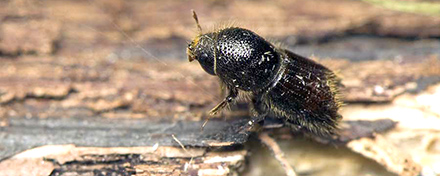
The rapid expansion of the spruce bark beetle, in combination with windstorms in Europe, has grown to a massive scale in just a few years, and the net impact is a huge timber salvage program, with far-reaching implications in global markets. Source: Timberbiz
Exceptionally hot and dry summers have fanned the flames for an unprecedented outbreak of spruce bark beetles throughout central European forests, killing vast areas of timber.
Drought, brought on by climate change, has weakened mature trees’ natural defense mechanisms, giving beetles a wide-open field to multiply unchecked.
The resulting massive infestation has forced landowners to quickly harvest their attacked forests across the Bavarian region of Germany, as well as in the Czech Republic, northern Austria, Slovakia, Poland and half a dozen other European countries.
As first presented in the November 2018 issue and with an update in the September 2019 issue of Wood Markets Monthly International Report, FEA has estimated the central European volume of damaged timber at over 100 million m3 in 2018, including both wind-damaged timber and beetle-killed wood.
While Germany has the most damaged timber in Europe, the Czech Republic’s spruce forest is highly stressed and there is the danger of losing up to 80% of its spruce trees over time – trends that are going to create a potential local timber shortage when the beetle epidemic has played out.
With an oversupply of sawlogs in Central Europe, dead and damaged logs are being offered at €40-50m3 (US$44–55/m³) ex-forest road – almost half of what they were selling for just 18 months ago.
For older beetle damaged timber and industrial log grades, the ex-forest prices are even lower.
In the 1990s and 2000s, a number of German companies (as well as some in neighbouring countries) built large, modern sawmills that featured kilns and large planers. These mills were designed to exploit US and other markets including Australia and Japan, that used planed lumber.
Unlike many markets in Europe, the US, Australia and China all accept blue-stained lumber, so much of this dead/damaged timber is being re-directed to these regions to move it out of Europe.
With plunging log prices and with low-cost manufacturing costs, Central European sawmills have quickly become some of the lowest cost mills in the world – allowing them to be competitive in almost all export markets.
Exacerbating this stark scenario is the European spruce log export story to China: up to the end of October, European log exports to China imports were a whopping 5.6 million m3. The pace of exports has been more than one million m3 per month in September and October and is now more than North America’s log exports to China this year.
Current C&F China log prices for European spruce logs have been steadily dropping as the volume increased – they are now down to about €95–96/m³ (US$105/m³) from €117/m3 (US$130/m3) in 2019Q2. Such low log prices coupled with high inventories have started to curtail production in higher cost log exporting regions such as Siberia, the Russian Far East and the British Columbia Coast, just to name a few.
As compared with the mountain pine beetle epidemic in the British Columbia Interior, FEA-Canada expects that the European spruce beetle could have an even greater net impact on its forests, although the magnitude will depend if the hot and dry summers continue and more windstorms occur from climate change.





